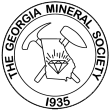"Enhydros"
Terminology that's all wet
by
Julian Gray, P.G.

Mineral dealers at rock shows will occasionally offer specimens labeled enhydros for sale. What they are selling are typically quartz crystals with liquid inclusions. Within the liquid is a tiny bubble and if you tip the crystal back and forth the bubble will move. The dealers will often circle the bubble and if you cannot find the bubble, the dealer will spend a lot of time searching with you. Most require that you use a magnifier. So what are these things?
First of all they are fluid inclusions, not enhydros, and they are also much more common that you might imagine. I will define both, but here is how fluid inclusions form. Minerals grow by adding elements to their surfaces, edges, and corners. Quartz crystals grow in many environments, but they commonly form by growth out of a hydrothermal solution – hot ground water containing dissolved silica. Growth rates and mechanisms are complex subjects and some scientists spend years on this single area of research. It is enough for our purposes here to know that different parts of a single crystal or crystal face can grow at different rates. When this happens microscopic pits develop in the crystal faces. These become the vessels for our bubble bearing liquid. Think of the hopper shaped halite or copper crystals that you’ve seen or those deep cavities or the faces of some Brazilian quartz. As the crystal grows larger, the next layer or several layers of crystal growth can cover these pits trapping the liquid that the crystal in the process. Now the fun begins!
When a liquid is heated it expands, when it cools it contracts. Solids like quartz also expand and contract, but to a much smaller rate. An everyday example of expanding and contracting liquids is the liquid in a glass thermometer. The glass in a thermometer also expands and contracts, just not nearly as much as the mercury or colored alcohol in the tube. When our quartz crystal is finished crystallizing it cools down (and so does the liquid in the inclusion). The cooling liquid contracts and may pull away from the sides of its tiny quartz container forming a vapor bubble.
Scientists call these trapped liquids and their bubbles fluid inclusions. They are quite common and very fascinating. The white color of milky quartz is due to thousands or perhaps millions of microscopic fluid inclusions. Gemologists see inclusions when they look at certain gemstones (emerald is a good example) with a microscope. The liquid is not always water. A common fluid in ore forming processes is salty water. Hot water can dissolve a lot more salt than cold water and some inclusions trap this hot salt water. When the salt water cools and contracts it too forms a bubble. But another interesting thing happens; because the water has cooled down it can no longer hold as much salt as it did when it was hot. The salt begins to crystallize out as a halite crystal within the fluid, which in turn is trapped in the quartz crystal. Imagine peering into a microscope and seeing an inclusion with a tiny vapor bubble and microscopic halite crystal! (micromounters eat your heart out.) Other things found in these fluid inclusions are carbon in fluids in Herkimer diamonds (doubly terminated quartz crystals from Herkimer, New York) and oil in fluorite from Elmwood, Tennessee. (Oil often fluoresces – check out your fluorite!) There are many more examples of wild stuff trapped in minerals (Roedder, 1972).
And let’s think about this for a minute: the fluid in the inclusion is an actual sample of fluid in which the mineral was growing! For this reason fluid inclusions are geochemical time capsules for scientists. Techniques have been developed to study these inclusions and determine their composition and exact means of trapping (Roedder, 1962 and 1984). They tell us how minerals grow, how ore deposits form, and even guide us to oil or metal deposits. They also add or detract from the value of gemstones. And they are simply entertaining to watch. I have a large inclusion in amethyst from the pegmatites in Brandenburg, Namibia. You can see the inclusion through a prism face of the amethyst without a magnifier. The bubble will move around its triangular home in the amethyst when you rotate the crystal 360 degrees.
So what is an enhydro? The American Geological Institute’s Glossary of Geological Terms (Bates and Jackson, 1987) defines an enhydros as “a hollow nodule or geode of chalcedony containing water, sometimes in large amounts.” This is different from the fluid inclusions that we have been talking about thus far. Remember that chalcedony is a microcrystalline, fibrous variety of quartz. Chalcedony is made up of hundreds or thousands of tiny elongated quartz crystals. These fibrous crystals grow from ground water flowing through a rock, commonly basalt or other volcanic rock. The silica-bearing ground water begins precipitating quartz when it enters a cavity. The chalcedony may entirely fill the cavity forming a nodule or it may leave a void in the center to form a geode. If it forms a geode, then some of the remaining liquid may become trapped in the void. Everyone is familiar with geodes and we all know that the crystal-lined voids in the center can be several inches in diameter – they could hold a lot of water! Mineral dealers who sell true enhydros cut the water-containing geode so that they miss the center of the geode, which would release the water. If you see an enhydros it will look like a chalcedony nodule, but if you shake the enhydros the water will move around.
Scientists call the quartz with moving bubbles fluid inclusions. That is what they are and that is what we should call them – fluid inclusions. Geodes with water are called enhydros. It would be better to call the things we see at gem shows “bubbles” than enhydros. Not a single article or book on fluid inclusions that I have seen even mentions the term enhydros.
There is a significant difference between enhydros and fluid inclusions. While enhydros may form by trapping water at the time they are formed, the walls of the geode are porous and water can leave or enter the enhydros. This happens in nature before we find and collect the enhydros. Ground water may continue to flow in and out of enhydros until we collect them, then water only seeps out. Some books warn that enhydros should be sealed to prevent leaking (not to worry, this process is very slow). This means that the water in the enhydros may not be the same water that was trapped when the geode grew (Matsui et al., 1974). Fluid inclusions trap water from which the mineral grew. The walls of a fluid inclusion are solid and non-porous. Only under special, but not completely uncommon, circumstances will a fluid inclusion leak (Roedder, 1984). The water in the fluid inclusion is commonly the water that was trapped when the crystal grew. Some scientists have examples of fluid inclusion dating the early Precambrian. That’s amazing. These Precambrian fluid inclusions may hold water that is over three billion years old!
Can fluid inclusions leak? Yes, but this happens rarely and typically if a crystal is fractured at some point. Careful examination of the crystals with a microscope can reveal clues as to whether a fluid inclusion is primary and has not leaked. Minerals that exhibit cleavage are more susceptible to leakage: calcite, barite, and fluorite for instance.
Enhydros are scientific curiosities; fluid inclusions are a scientific research tool. It’s sort of like the fluid equivalent of the difference between a rock and a mineral. It is incorrect to label a mineral with a fluid inclusion an enhydros. A label calling attention to the fact that a mineral bears fluid inclusions is correct and should even increase the value of a specimen because of the scientific value and unique circumstances under which these formed. Now get busy changing those labels!
References:
Bates, R. L., and Jackson, J. A., 1987, Glossary of Geological Terms – Third Edition: American Geological Institute, Alexandria, Virginia, 788 p.
Matsui, E., Salati, E., and Marinin, O. J., 1974, D/H and 18O/16O ratios in water contained in geodes from the basaltic province of Rio Grande del Sul, Brazil: Geological Society of America Bulletin, v. 85, p. 577-580.
Roedder, E., 1962, Ancient fluids in crystals: Scientific American, vol. 207, p. 38-47.
Roedder, E., 1972, The composition of fluid inclusions: U.S. Geological Survey Professional Paper 440-JJ, 164 p.
Roedder, E., 1984, Fluid Inclusions: Mineralogical Society of America Reviews in Mineralogy Volume 12, 646 p.

Copyright © Georgia Mineral Society, Inc.
